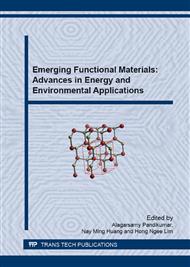[1]
B. O. Regan, M. Gratzel, Photoelectrochemical Solar cells, Nature. 353 (1991) 737-742.
Google Scholar
[2]
Michael Grätzel, Solar Energy Conversion by Dye-Sensitized Photovoltaic Cells, Inorg. Chem. 44 (2005) 6841–6851.
DOI: 10.1021/ic0508371
Google Scholar
[3]
Ahmed Afifi and Mohammad Kazem Tabatabaei, Efficiency investigation of dye-sensitized solar cells based on the zinc oxide nanowires, Oriental Journal of Chemistry. 30 (2013) 155-160.
DOI: 10.13005/ojc/300118
Google Scholar
[4]
T. G. Deepak, G.S. Anjusree, Sara Thomas, T. A. Arun, Shantikumar V. Nair and A. Sreekumaran Nair, A review on materials for light scattering in dye-sensitized solar cells, RSC Advances. 4 (2014) 17615-17638.
DOI: 10.1039/c4ra01308e
Google Scholar
[5]
J. Desilvestro, S.M. Tulloch, and G.E. Tulloch; Volume Manufacture of Dye Solar Cells - A Materials Perspective, Inter. Conf. on Nanoscience and Nanotechnology, Melbourne, Australia, 25-29 February, (2008).
Google Scholar
[6]
Yasuhiro Tachibana, Jacques E. Moser, Michael Gratzel, David R. Klug, and J. R. Durrant; Subpicosecond Interfacial Charge Separation in Dye-Sensitized Nanocrystalline Titanium Dioxide Films, J. Phys. Chem., 100 (1996) 20056-20062.
DOI: 10.1021/jp962227f
Google Scholar
[7]
Jenny Nelson, Saif A. Haque, David R. Klug and James R. Durrant, Trap-limited recombination in dye-sensitized nanocrystalline metal oxide electrodes, Physical Review B, 63(2001) 205321.
DOI: 10.1103/physrevb.63.205321
Google Scholar
[8]
Jenny Nelson; Continuous-time random-walk model of electron transport in nanocrystalline TiO2 electrodes, Physical Review B, 59 (1999).
Google Scholar
[9]
L. Dloczik, O. Ileperuma, I. Lauermann, L. M. Peter, E. A. Ponomarev, G. Redmond, N. J. Shaw and I. Uhlendorf, Dynamic Response of Dye-Sensitized Nanocrystalline SolarCells: Characterization by Intensity Modulated Photocurrent Spectroscopy, J. Phys. Chem. B , 101 (1997).
DOI: 10.1021/jp972466i
Google Scholar
[10]
Zhen Wei, Yu Yao, Tao Huang, Aishui Yu, Solvothermal Growth of Well-Aligned TiO2 Nanowire Arrays for Dye-Sensitized Solar Cell: Dependence of Morphology and Vertical Orientation Upon Substrate Pretreatment, Int. J. Electrochem. Sci. 6 (2011).
DOI: 10.1016/j.electacta.2011.06.038
Google Scholar
[11]
M. Riazian and A. Bahari, The growth of thin Titanium oxide (TiO2) film and nano size TiO2 powder, International Journal of the Physical Sciences. 6 (2011) 3756-3767.
Google Scholar
[12]
Jun Hyuk Yang, Chung Wung Bark, Kyung Hwan Kim and Hyung Wook Choi, Characteristics of the Dye-Sensitized Solar Cells Using TiO2 Nanotubes Treated with TiCl4, Materials. 7 (2014) 3522-3532.
DOI: 10.3390/ma7053522
Google Scholar
[13]
S. Kambe, S. Nakade, Y. Wada, Effects of crystal structure, size, shape and surface structural differences on photo-induced electron transport in TiO2 mesoporous electrodes, J. Mater. Chem. 12 (2002) 723-728H.
DOI: 10.1039/b105142n
Google Scholar
[14]
X. Liu, J. K. Thomas, Synthesis of microporous titanosilicates ETS-10 and ETS-4 using solid TiO2 as the source of titanium, Chem Commun. 26 (1996) 1435-1436.
DOI: 10.1039/cc9960001435
Google Scholar
[15]
N. G. Park, Van De J. Lagemaat, A. J. Frank, Comparison of dye-sensitized rutile and anatase based TiO2 solar cells, J Phys Chem B. 104 (2000) 8989-8994.
DOI: 10.1021/jp994365l
Google Scholar
[16]
Divya Jyoti, Devendra Mohan and Rakesh Dhar, Investigation of Transport and Optical Properties of Mesoporous Anatase and Rutile TiO2 Films for Application in Dye-Sensitized Solar cells, Modern Physics Letters B. 26 (2012), 1250123-8 pages.
DOI: 10.1142/s0217984912501230
Google Scholar
[17]
P. Rouard, Etudes des propriétés optiques des lames metalliques très minces, Ann. Phys. 7 (1937) 291-384.
DOI: 10.1051/anphys/193711070291
Google Scholar
[18]
K. C. Park, The Extreme Values of Reflectivity and the Conditions for Zero Reflection from Thin Dielectric Films on Metal, Applied Optics. 3 (1964) 877-881.
DOI: 10.1364/ao.3.000877
Google Scholar
[19]
R. Swanepoel, Determination of surface roughness and optical constants of inhomogeneous amorphous silicon films, J. Phys. E. 17(1984) 896-903.
DOI: 10.1088/0022-3735/17/10/023
Google Scholar


